Ok, so now that you know where cavities are most commonly found, let's take a look at the different types of caries that patient's can have. Over the next two pages, we'll take a quick look at various types of caries. And yes, these pages are a little long. But that's only because of all the wonderful pictures I am trying to show you!
This normal type of decay occurs in most patients. It is a slowly progressing, continuous process that take's about 4 years for the cavity to pass through the enamel of the tooth.
This decay signifies advanced or severe decay that's present on multiple surfaces of teeth. It can be seen in those with xerostomia , poor oral hygiene, methamphetamine
, poor oral hygiene, methamphetamine use (drug-induced dry mouth) and / or a large sugar intake.
use (drug-induced dry mouth) and / or a large sugar intake.
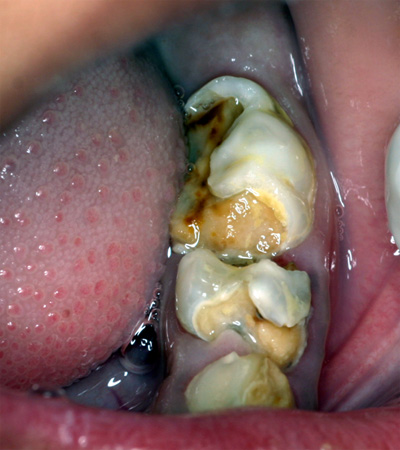
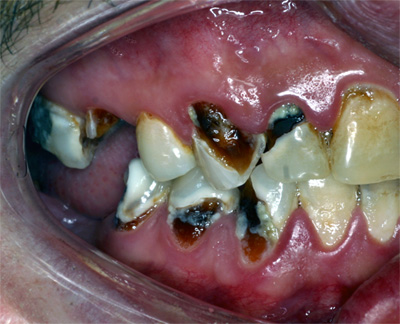
This decay represents a type of rampant caries that may be seen when a patient undergoes head and neck radiation therapy. The patient is given high doses of radiation as a means of killing the cells of the cancer. Unfortunately, normal cells will die as well. If a salivary gland is directly in the field of radiation, the radiation will kill the normal cells of the salivary gland. A non-functioning salivary gland fails to create salivary secretions and xerostomia results. This xerostomia, along with a change in the oral microflora, a decrease in the cleansing abilities of the saliva and a change in the oral cavity's pH will all factor into the development of quickly progressing dental caries.
caries that may be seen when a patient undergoes head and neck radiation therapy. The patient is given high doses of radiation as a means of killing the cells of the cancer. Unfortunately, normal cells will die as well. If a salivary gland is directly in the field of radiation, the radiation will kill the normal cells of the salivary gland. A non-functioning salivary gland fails to create salivary secretions and xerostomia results. This xerostomia, along with a change in the oral microflora, a decrease in the cleansing abilities of the saliva and a change in the oral cavity's pH will all factor into the development of quickly progressing dental caries.
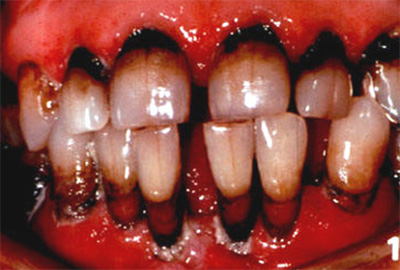
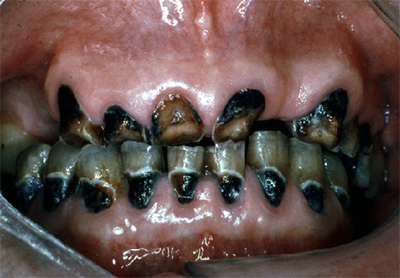
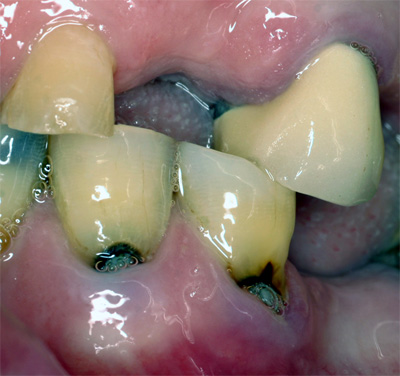 Root caries is a quickly occurring decay process that is usually found when root surfaces have been exposed (due to gingival recession) and is most commonly noted on the facial surfaces. The root surface at the CEJ is more vulnerable to the demineralization process- cementum begins to demineralize at a pH of 6.7, whereas enamel's critical pH (where it begins to demineralize) is 5.5 (takes a lower pH is cause it's demineralization).
Root caries is a quickly occurring decay process that is usually found when root surfaces have been exposed (due to gingival recession) and is most commonly noted on the facial surfaces. The root surface at the CEJ is more vulnerable to the demineralization process- cementum begins to demineralize at a pH of 6.7, whereas enamel's critical pH (where it begins to demineralize) is 5.5 (takes a lower pH is cause it's demineralization).
As mentioned earlier, root caries is commonly seen in aging patients. As a patient ages, the number of medical conditions and the medications that they will be on will increase. Many medications cause xerostomia as a side effect. A reduction in salivary flow due to the physiology of aging and the patient exhibiting a decrease in manual dexterity will also come into play.